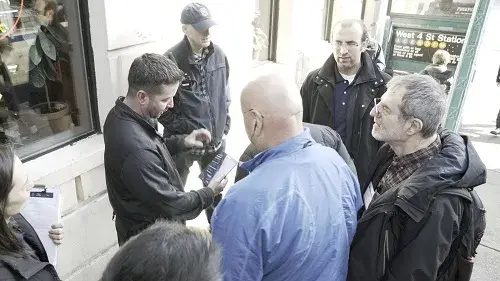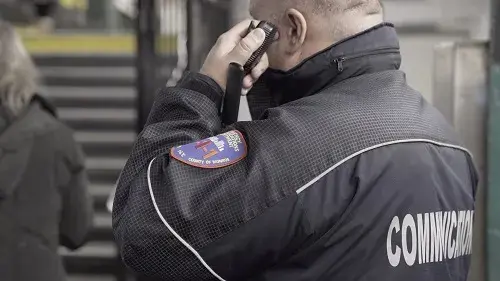With the abundance of tools and technologies available to assist first responders, it’s important to address questions such as: How do the tools perform in real-world response situations? Can they withstand uncertain environments? Are they easy to use when a responder is wearing protective gear? How heavy is the technology? Will it weigh down, or fit within the gear of a responder who is already wearing their full kit? The Department of Homeland Security Science and Technology Directorate (S&T) First Responders Group (FRG) wants to help first responders answer these questions so they can make informed decisions about technology acquisition.
 Recently, FRG’s National Urban Security Technology Laboratory (NUSTL) hosted an Urban Operational Experimentation (OpEx) to find answers to these types of questions. The three-day event is an annual gathering of more than 70 participants from federal, state and local first responder agencies from various disciplines, as well as private industry and academia partners. They gathered to experiment with four emerging first responder technologies in realistic operational scenarios. The event was held in coordination with the New York City Police Department (NYPD), New York City Fire Department (FDNY), New York City Emergency Management (NYCEM) and the Port Authority of New York and New Jersey (PANYNJ).
Recently, FRG’s National Urban Security Technology Laboratory (NUSTL) hosted an Urban Operational Experimentation (OpEx) to find answers to these types of questions. The three-day event is an annual gathering of more than 70 participants from federal, state and local first responder agencies from various disciplines, as well as private industry and academia partners. They gathered to experiment with four emerging first responder technologies in realistic operational scenarios. The event was held in coordination with the New York City Police Department (NYPD), New York City Fire Department (FDNY), New York City Emergency Management (NYCEM) and the Port Authority of New York and New Jersey (PANYNJ).
The first day was spent experimenting with FABIS-Mobile, a facial recognition software designed to enable users to perform real-time identification of individuals using still or video camera images. On the second and third days, first responders experimented with Haystax and LifeRing, two incident management communication technologies, and TSM Tactical Radios, which self-form into a mesh communication network without the need for fixed infrastructure.
Technology evaluators, observers and data collectors included members of S&T’s First Responder Resource Group from Massachusetts, New York and Washington, as well as regional first responder representatives from NYPD, NYCEM, FDNY, PANYNJ, Customs and Border Protection and the Metropolitan Transportation Authority (MTA).
“Urban OpEx yields numerous benefits to all participants – technology developers and first responders alike,” explained NUSTL Director Adam Hutter. “It provides first responders with an opportunity to experiment with new technologies that could enhance their mission capabilities, gives technology developers direct feedback and input to consider when modifying their products to better meet first responder needs, and enhances NUSTL’s understanding of first responder needs and gaps to guide future homeland security investments.”
“The event was an extension on NUSTL’s mission focus in serving first responders and making sure they have the knowledge and tools they need to do their jobs,” said NUSTL Urban OpEx Program Manager Bhargav Patel.
“This year, we tried to place an emphasis on first responders from urban areas. We invited responders from Boston, Seattle, and engaged with the Offices of Emergency Management for the NYPD, Port Authority Police Department, and FDNY. Our goal is to put new technologies into their hands to see if it meets their mission needs, and if not, we want to know what needs to be changed,” Patel said.
Most of the technology developers were on-hand to train the first responder evaluators on their technologies and gather feedback about potential improvements. The event also provided responders from different disciplines an opportunity to meet and discuss their unique operational needs and different uses for the technologies.
Michael Lee, MTA Railroad Assistant Chief Security Officer for Technology and Projects, said he appreciated the opportunity to explore emerging technologies in a realistic setting and touch base with other responders.
“It’s helpful to know our strategic goals are aligned. If we’re looking at the same kind of technology,  we can absolutely compare the use-case scenarios and share some of the lessons learned from other technologies they might have already. This is almost a force multiplier,” Lee said.
we can absolutely compare the use-case scenarios and share some of the lessons learned from other technologies they might have already. This is almost a force multiplier,” Lee said.
Michael Gemelli, MTA New York City Transit’s Department of Security, was also at the event and agreed with Lee. He said he appreciates NUSTL’s focus on the technology and the objectivity of the research. Events like Urban OpEx remove the emphasis on marketing or selling the technology and puts it back on what it is, what it does and how it works in a realistic setting. By answering these questions, FRG helps first responders make informed decisions about which innovative tools and technologies can best meet their needs.
